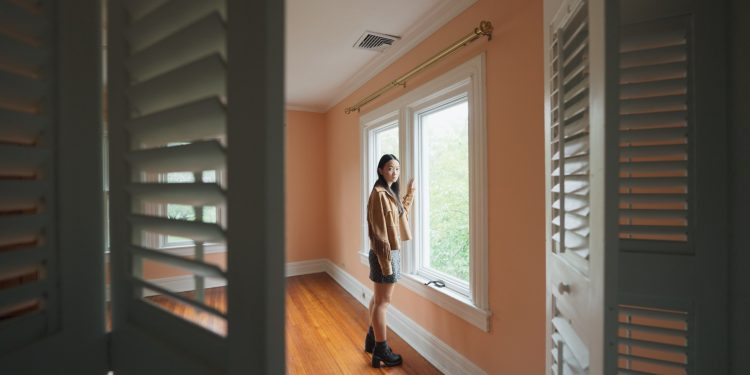The dazzling success of the 1999s The Blair Witch Project really did a number on the horror genre. It wasn’t the first found footage film, or even the first found footage horror film. But it landed at a time when handheld cameras were getting smaller and cheaper, horror was becoming more popular and mainstream, and Internet marketing allowed creators to target their ideal audience, thus transforming their film into viral creepypasta.
Between its enormous box office success and the apparent ease of reproducing it at a lower cost, The Blair Witch Project started a trend for found footage horror that has ebbed and flowed over the decades, and still occasionally resurfaces in projects like 2023’s Underground Sensation. Skinamarink. Inside Steven Soderbergh’s hypnotic, minimalist ghost story PresenceHowever, the found footage film style may have found its definitive form.
Presence focuses on a haunting in a luxuriously modernized century-old house, newly occupied by a struggling family full of fault lines. Waifish’s teenage daughter Chloe (Callina Liang) is in shock after the death of her best friend. His smug and arrogant older brother, Tyler (Eddy Maday), is unlikeable; the family has just moved entirely so he can get into a better school district, where his stardom on the swim team could take him further. Their parents, Rebekah (Lucy Liu) and Chris (Chris Sullivan) disagree on everything, especially how to deal with Chloe’s depression and possible drug addiction, and how to moderate Rebekah’s clear and unmitigated favoritism for Tyler. As they all go through their own emotional trials, an invisible, intangible presence – represented by the camera – roams the house, observing them all even in their most private moments.
Technically speaking, Presence is not really a found footage film in the Blair Witch Project vein. There is no pretense that Soderbergh’s first-person account is actual camera footage, much less “lost” camera footage discovered some time after the cameraman met a terrible fate. But everything about the film fits into the visual style widely known as found horror: the audience sees the entire film through Soderbergh’s lens, representing the single witness who connects all the narrative threads.
In this case, however, the camera is not a jittery, nauseating portable device, as in The Blair Witch Project, CloverfieldOr Behind the Mask: The Rise of Leslie Vernon. It is not a series of sources like security systems or static cameras, as in (REC) Or Paranormal activity. It’s a warmly lit, perfectly realized eye that moves through the story, gliding around the house and the new inhabitants with an inhuman gentleness that cuts through the strangeness of the entity. PresenceThe premise of the story is that the story is framed by a ghostly voyeur hovering over the actors, taking in their needs and fears, but initially unable to communicate his own.
Soderbergh’s approach draws on the found footage horror idea of a story experienced by whoever is behind the camera, except in this case the question of who is behind the camera is part of the horror. From the start, Soderbergh and screenwriter David Koepp (who also wrote Soderbergh’s simple and effective 2022 action thriller) Kimi) imply that the presence is a ghost – but until the action fully unfolds, the audience is left wondering whether it is something completely different, as well as what and how they want and whether he will eventually make his needs known. The filmmakers inevitably include a few small scares, but for the most part, Presence It’s a quiet, slow curiosity rather than a hidden terror.
For audiences who expect breathless turns of the usual found-footage horror playbook – the kind of barely glimpsed threats and dimly lit shocks that a fast-moving, low-fidelity camera delivers allows – Soderbergh’s approach may seem perverse. The bright, open character of the house and its richly appointed rooms make it an unlikely, even ill-suited, space for a haunting. There is no chance that the camera will suddenly capture an unexpected and horrible specter, because the camera East the spectrum.
Where another story might have transformed the ghost’s looming presence and intimate proximity to the characters into a constant, ominous threat, PresenceThe ghost seems harmless, even distant. Like the lonely, faceless ghost in David Lowery’s film A ghost storyhe seems either unable to touch the family or indifferent. Until it doesn’t.

Photo: Peter Andrews/The Spectral Spirit Company
But the uniqueness of this approach is part of its appeal. Presence is more intellectual than visceral, more concerned with raising questions than keeping viewers in their seats. Which makes it feel like a more adult version of the found footage film. If The Blair Witch represented the nervous adolescence of the subgenre, then format expansions like Without friends and similar horror films on screen were his experimental youth, and Presence is its full adult form.
As it grew, however, the genre lost much of its surprising, engaging brutality and truth-telling energy. Presence is more calm, sophisticated, and refined than its predecessors, but it’s also less emotionally engaging, despite its committed performances and the raw, painful feelings of grief, anger, resentment, and loneliness that the central family navigates. By presenting their story in just 85 minutes, Soderbergh and Koepp don’t give the premise or format enough time to be predictable, but they rarely give their story a sense of urgency or excitement. This is found footage horror as an intellectual exercise rather than a thrilling emotional one.
All this suggests Presence is just one more element in Soderbergh’s endless series of cinematic experiments with form, rather than a fashion-launching phenomenon in the vein of The Blair Witch Project. This is a final step for a still-evolving subgenre, not the start of a new one. For Soderbergh, who always had a desire to innovate and take films to the next level and then move on, that’s probably enough. For deep-rooted horror fans expecting a more familiar brand of scares, however, Presence may seem like a strange iteration on a familiar trope – something that seems more adult and more singular than all those increasingly identical one-camera horror films of decades past, but still not as fun.
Presence is in theaters now.


